| AIR
QUALITY (FILTRATION & PURIFICATION)
Austin Air Systems - Information will be available soon
Ultraviolet
Air disinfection is the safe, easy and reliable way to
make it healthier indoors!
The solution for Microbial
Contaminants in HVAC systems. Dirty Socks Syndrome. Sick Building
Syndrome. These are some of the names given to mold and bacterial
problems in HVAC systems. Ultraviolet light is a very cost effective
method of destroying bacteria, viruses, yeasts, and molds. Ultraviolet
light will kill or inactivate these micro-organisms. The benefits
are many; increased HVAC coil efficiency, lower maintenance costs,
improved indoor air health, and it's very affordable.
For over 70 years, ultraviolet light has been an effective tool
in destroying harmful pathogens. Many of the molds, bacteria,
and fungi, that cause odours and problems in your air handling
system, can be eliminated with the installation of ultraviolet
light. It is used widely in industry to keep food and liquids
germ-free during processing and packaging. It's also used in aircraft
ventilation systems to prevent the spread of pathogens and infectious
disease.
Our UV air disinfection equipment 'floods' an area of a home or
buildings HVAC system with UV light. As it circulates throughout
the system, it is automatically disinfected. This simple process
dramatically reduces airborne bacteria, viruses and allergens.
| 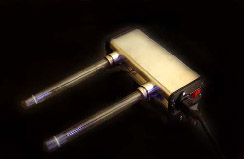
Shown
here is the UVInnovation UVIDII. Placed inside air duct.
Ideal for homes and businesses
|
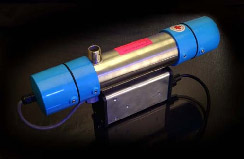 Shown
here is the UV Innovation UVIP. ideal for apartments, boats,
cars, etc.
Shown
here is the UV Innovation UVIP. ideal for apartments, boats,
cars, etc. |
Features:
- Medical studies
prove the effectiveness of ultraviolet light.
- Available for residential,
commercial, industrial, and also portable applications.
- Eliminates or prevents
mold growth on HVAC coils, allowing them to operate at peak
efficiency.
- Actually destroys
bacteria, viruses, fungi, yeast, and molds.
- Inexpensive to
operate. Only pennies per day.
- High output, long
life UV lamps.
- Great for homes,
restaurants, offices, hospitals, schools, etc.
- Surface or airborne
microbial control.
- Low maintenance
and reduced costs.
The EPA says that indoor
air is one of the top five environmental health risks of our time.
And the Centre for Disease Control offers guidelines for using
UV to disinfect the air.
UV Air disinfection
systems work automatically -24/7
UVGI can control microbial
growth on filters subject to moisture or high humidity. Photos
A and B show an unirradiated and irradiated filter bank, respectively.
The unirradiated filters show natural contamination from various
fungal species, including Aspergillus and Penicillium, while the
irradiated filters show no evidence of microbial growth. The system
in Photo B used lamps that produce a rated intensity of 100 microW/cm2
at 1 m from their midpoints.
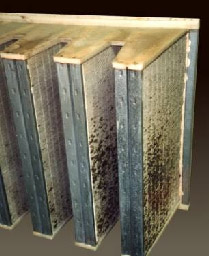
Microbial
growth on unirradiated filters |
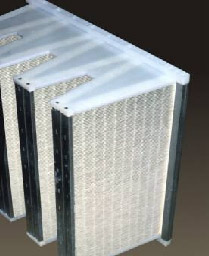
Microbe-free
irradiated filters |
| Photos
courtesy of Airguard Industries, Louisville.
|
TYPES OF MICROORGANISMS
The variety of microbes encountered by a given UVGI system is
essentially unpredictable. It depends to some degree on the type
of facility and geographic location.
All viruses and almost all bacteria (excluding spores) are vulnerable
to moderate levels of UVGI exposure. Because viruses are primarily
contagious pathogens that come from human sources, they are found
in occupied buildings. Bacteria can be contagious or opportunistic,
with many found indoors; however, some are environmental. Certain
facilities, such as agricultural buildings, may disseminate unique
types of bacteria such as spore-forming actinomycetes.
Spores, which are larger and more resistant to UVGI than most
bacteria, can be controlled effectively through the use of high
efficiency filters. The coupling of filters with UVGI is the recommended
practice in all health care settings8 and for UVGI applications
in general.
DESIGN PARAMETERS
A number of parameters must be considered when considering UVGI
products for HVAC designs. The most important factors are the
airflow or HVAC equipment that will be disinfected, the lamp wattage
and distance, and the ventilation system design itself.
Air-stream characteristics
The characteristics
of an air-stream that can impact UVGI design are relative humidity
(RH), temperature, and air velocity.
Increased RH is commonly believed to decrease decay rates under
ultraviolet (UV) exposure. However, studies on this matter are
contradictory and incomplete at present. Fortunately, because
most UVGI studies were conducted under normal indoor conditions,
typical room and in-duct applications are not likely to differ
greatly. Air temperature has a negligible impact on microbial
susceptibility to UVGI10. However, it can impact the power output
of UVGI lamps if it exceeds design values.
Operating a UVGI
system at air velocities above design will degrade the system's
effectiveness because of the cooling effect of the air on the
lamp surface, which, in turn, will cool the plasma inside of the
lamp. UV output is a function of plasma temperature when power
input is constant.
Not all UVGI
lamps have the same response to cooling effects. Some lamps have
different plasma mixtures; overdriven power supplies that respond
to plasma temperature; or UV-transparent, infrared-blocking shielding
that limits cooling effects. Data from the manufacturer should
be consulted to determine the cooling effects or the limiting
design air velocities and temperatures within which the lamps
can be efficiently operated.
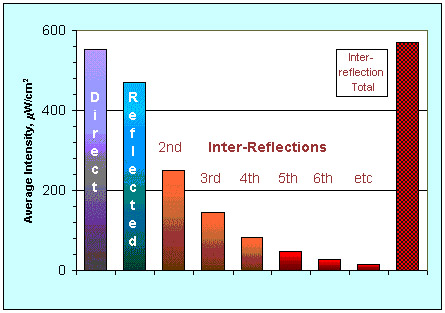
Figure
5: calculated additional light intensity from reflections and
inter-reflections. Total intensity is the sum of direct, reflected
and inter-reflected UV light.
VENTILATION SYSTEM DESIGN
A number of ventilation system parameters can impact UVGI design.
Air velocity and air mixing. Doses are determined by the time
of exposure and UVGI intensity, both of which are dependent on
the velocity profile and amount of air mixing in the air stream.
The velocity profile inside the duct or chamber depends on local
conditions and may be impossible to know in advance with any certainty.
In any event, the design velocity of a typical UVGI unit is similar
to that for filter banks -- about 400 fpm. Sufficient mixing will
occur at these velocities to temper the effects of a non-uniform
velocity profile.
The amount of air mixing that occurs will affect system performance
to a degree that depends on system configuration. This is illustrated
in Figure 4
which compares the survival predictions for mixed- and unmixed-flow
conditions in square ducts of increasing dimension. The error
resulting from the assumption of complete mixing will decrease
as system dimensions increase.
In systems where the lamps do not span the entire duct width or
length, the assumption of complete mixing also will result in
larger differences, compared to unmixed flow. The important point
is that system operation will lie somewhere between these two
assumptions, which provide limits describing system efficiency.
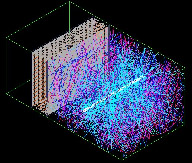
Figure
6. Ray-tracing computer model of a cooling coil bank irradiated
with a UVGI lamp. Rays are color-coded from blue to red in order
of decreasing intensity. Image was generated using Photopia software
from Lighting Technologies, Inc., Boulder, CO.
Using reflectors.
Reflectivity can be an economical way of intensifying the UVGI
field in an enclosed duct or chamber. A surface with a reflectivity
of 90 percent will reflect 9/10 of the light it receives.
The results of a computer-generated analysis of reflectivity are
shown in Figure 5. The components of reflectivity -- both direct
and inter-reflected -- will clearly sum to greater than the initial
direct intensity. This can occur whenever the surface is mostly
enclosed and highly reflective. Such designs can considerably
improve economics.
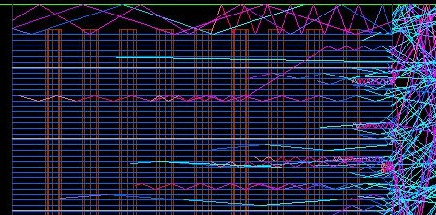
Figure
6b. Ray-tracing computer model of a cooling coil bank irradiated
with a UVGI lamp. Twenty reflections are shown with 90 percent
reflective surfaces. Image was generated using Photopia software
from Lighting Technologies, Inc., Boulder, CO.
Two types of reflective
surfaces exist: specular and diffuse. Specular surfaces produce
mirror-like reflections that are directionally dependent on the
source, while diffuse surfaces produce non-directional reflections
that spread equally in all directions. Non-glossy white paper
is a good example of a diffuse surface. Most materials possess
a combination of specular and diffuse properties and exhibit a
degree of directional dependence. For UVGI design purposes the
degree of directional dependence is usually not critical.
Some materials reflect visible light, but not UV light. Polished
aluminum is highly reflective to UV wavelengths, while copper,
which reflects most visible light, is transparent in the UV range.
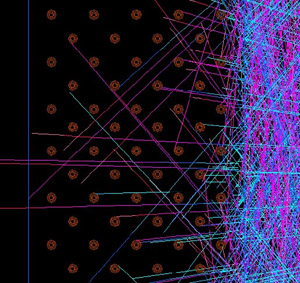
Figure 6c.
Ray-tracing computer model of a cooling coil bank irradiated with
a UVGI lamp. The staggered 5/4 coil tubes are 0.5 in. dia. with
six fins per inch. Image was generated using Photopia software
from Lighting Technologies, Inc., Boulder, CO.
No simple method of
calculating the three-dimensional UVGI-intensity field for specular
reflectors exists. Ray-tracing routines using Monte Carlo techniques,
are one approach, but the results do not easily lend themselves
to analysis. However, they can be rather useful for examining
complex geometries, such as when cooling coils are irradiated.
Figure 6 shows ray-tracing diagrams of a UVGI lamp irradiating
a bank of cooling coils from three perspectives. Note how few
of the rays penetrate the coils, even after 20 reflections. Also
note how the copper tubes absorb many of the rays -- although
(pure) copper is transparent to UVGI the water inside is not.
Combining with filtration
UVGI systems generally are used in combination with HEPA filters,
a practice usually recommended for isolation-room applications.
For other applications, however, HEPA filters do not offer a significant
enough improvement in microbial-removal rates over high efficiency
filters to warrant their exclusive use with UVGI.
Recirculation systems
UVGI systems that recirculate room air or that are placed in a
return-air duct or mixing-air plenum deliver multiple doses to
airborne microorganisms. Although the effect is partially dependent
on the air change rate, the result is an effective increase in
removal rate in comparison wit a single-pass system.
Calculations of removal rates for UVGI and associated filters
in recirculation systems can be performed by evaluating the system
minute-by-minute, including filtration rates, outside-air rates,
and any microbial contaminants.
Lamp considerations
The hardest part of sizing a UVGI system is determining the lamp
wattage for the stated disinfection goal. The intensity field
caused by the lamp and the reflectors must be modeled and averaged
before equation 1 is used to predict the disinfection rate.
Calculating
the Intensity Field of a UVGI Lamp
The intensity field of a UVGI lamp can be computed using
the following radiation view factor from a differential
planar element to a cylinder, perpendicular to the cylinder
axis (Modest, M.F. 1993. Radiative Heat Transfer. McGraw-Hill,
New York):

The parameters in the above equation are defined as follows:

where l = length of the lamp segment, cm
x = distance from the lamp, cm
r = radius of the lamp, cm
The intensity at any point will be the product of the view
factor and the surface intensity of the lamp. The surface
intensity is simply the UV power output in watts divided
by the surface area in cm2.
To compute the intensity at any distance from the midpoint
of the lamp, multiply the above equation by 2. From any
location other than the midpoint, divide the lamp into two
unequal segments and add the two view factors. View-factor
algebra (see reference) can be used for other locations.
If we assume that complete mixing occurs, then the intensity
field for any duct can be computed by averaging the field
in all three dimensions. |
Lamp-intensity field
An exact description of the lamp-intensity field is necessary
to accurately determine the dose that is to be delivered to an
airborne microorganism. Lamp ratings often are the sole parameter
used for sizing a UVGI installation. Although this may be a conservative
approach when distances to the lamp exceed 1 meter, oversizing
and prohibitive economics can result.
If complete mixing is assumed, then any intensity field can be
described by the single value of average intensity. This requires
computing the intensity at every point in a three-dimensional
matrix defining the duct. We need to know the field caused by
the lamp and, if necessary, the field caused by the reflections.
Although the inverse-square law has been used for this purpose,
it has proven to be inaccurate close to the lamp. An improved
approach is to use the radiation view factor from a differential
planar element to a cylinder as detailed in the sidebar Calculating
the Intensity Field of a UVGI Lamp. Ignoring reflectivity, the
average intensity field can be conservatively computed by applying
Equation 3 to a three-dimensional matrix.
There are view factors that can be used for computing the reflected
intensity from flat parallel or perpendicular surfaces. Consult
any thermal-radiation textbook for such view factors. First, use
Equation 3 to determine the intensity at the flat surface. Then,
use the appropriate view factor to determine the reflected intensity
after multiplying by the reflectivity.
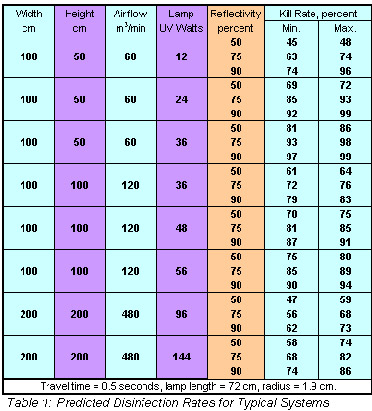
Table 1: presents a comparison of UVGI systems
that were sized using the view-factor method and may be used to
approximate the performance of similar systems.
CONCLUSIONS
Although
simplistic, the methodology presented here is more accurate than
any previously published method for sizing UVGI systems. The authors
hope that these principles will lead to successful applications
and avoidance of the design problems that have hampered the industry
and perplexed engineers. Although the goal of eliminating airborne
disease might remain unachievable, the information presented here
may help lead the industry back to the path of continuous improvement.
The use of ultraviolet
germicidal irradiation (UVGI) for the sterilization of microorganisms
has been studied since the 1930s. Microbes are uniquely vulnerable
to the effects of light at wavelengths at or near 2537 Angstroms
due to the resonance of this wavelength with molecular structures.
Looking at it another way, a quanta of energy of ultraviolet light
possesses just the right amount of energy to break organic molecular
bonds. This bond breakage translates into cellular or genetic
damage for microorganisms. The same damage occurs to humans, but
is limited to the skin and eyes.
The ultraviolet component of sunlight is the main reason microbes
die in the outdoor air. The die-off rate in the outdoors varies
from one pathogen to another, but can be anywhere from a few seconds
to a few minutes for a 90-99% kill of viruses or contagious bacteria.
Spores, and some environmental bacteria, tend to be resistant
and can survive much longer exposures. UVGI systems typically
use much more concentrated levels of ultraviolet energy than are
found in sunlight.
Some properly designed, and well-maintained, UVGI installations
have proven highly effective, as in certain hospitals, and some
studies perfomed in schools. CDC guidelines recommend the use
of UVGI only with the simultaneous use of HEPA filters and high
rates of purge airflow. The germicidal effects can also be species-dependent.
Laboratory tests have achieved extremely high rates of mortality
under idealized conditions. In actual applications, many factors
can alter the effectiveness of UVGI, including the following :
- Exposure time (the
air velocity must allow for a sufficient dose).
- Room air mixing
(for non-powered applications like ceiling units).
- Power levels.
- The presence of
moisture or particulates provide protection for microbes
- Dust settling on
light bulbs can reduce exposures, maintenance is necessary.
One
especially effective application of UVGI is the control of microbial
growth in air handling unit cooling coil and filter assemblies.
The constant exposure has been found to be very effective at
controlling fungal growth, either because the spores are inactivated,
or perhaps because mycelial growth cannot be sustained under
continuous exposure.
Certain types of UVGI designs seem to provide a much higher
rate of disinfection than standard models operating at nearly
identical spectrums, the difference being the result of improvements
in the electrical power controls and regulation of internal
plasma temperature, resulting in the generation of a more constant
energy density at a distance from the light source.
Viruses are especially susceptible to UVGI, more so than bacteria,
but are also very difficult to filter. Some studies have shown
that viruses are more sensitive to ultraviolet radiation at
wavelengths somewhat above the normal UVGI broad-band wavelength
of 2537 A (Rauth 1965; Setlow 1961). A combination of filtration
for bacteria and spores, with UVGI for viruses may be an optimum
combination if all components are sized appropriately.
UVGI THEORY & RATE CONSTANTS FOR AIRBORNE PATHOGENS
UVGI inactivates pathogens according to the standard decay equation
S = exp(-kIt)
In this
equation S represents the fraction of the original population
that survives exposure at time t, and I represents the UVGI
intensity. The rate constant k has been determined experimentally
for a number of bacteria, viruses and spores, at different power
levels. Summarized below are many of the known rate constants
for the indicated pathogens. Since many researchers have obtained
values that differ, they have all been included. The source
documents may be found in the references.
|





























